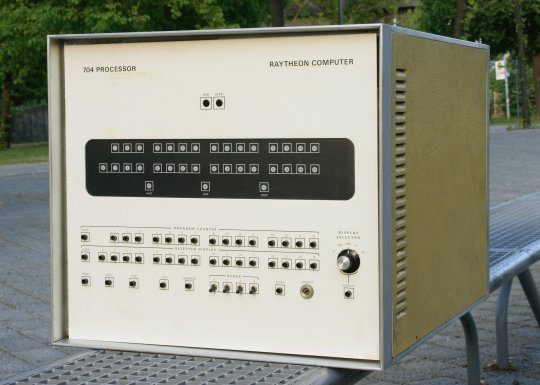Raytheon 704

| Manufacturer: | Raytheon |
| Type: | 704 |
| Year: | 1969 |
| Technology: | TTL, DTL, 16K core memory |
Available peripherials include a teletype and a peripherals-rack to which a Ferranti highspeed papertape-reader and a digital tape drive can be attached.
Fortunately the documentation - circuit layout, description of the system architecture and software on papertape (FORTRAN, Assembler, Word Processor, Test programs and FORTRAN-examples) - were included. This device is a real disaster computer: When we picked it up the Teletype bid farewell to go on a trip to the floor, as soo as it was unscrewed from its pedestal. Mrs. Dr. Erika Fuchs descriped a similar event, when a certain Donald D. flew down the stairs with a bowl of lightbulbs, onomatopoetic with 'klickerradomms'. Luckily a Teletype is a solid instrument, so that a small drop could not do much harm. Upon inspection of the debries from the casing we discovered traces of glue, indicating that the very same mishap has happened more often during the last 32 years.
After we had removed every dent, glued everything back together and scrubbed and readjusted the contacts of the keyboard and papertape-reader everything worked great, until one day, when it started to smell spicy in the museum and the lights on the front panel went off. Due to a jammed fan the commutator overheated and went up in smoke. The commutator could not be saved, it hat to be replaced. By removing a dozen slices, protection rings, rubber membranes, felt rings and metal caps the fan could be disassembled. After much cleaning and a last oiling prior to reassembling it now once more fans like aeolus.
FYI: The power supply unit is equipped with two magnetic current regulators, much like that of the LGP-30. Shunttransistors then do the fine tuning of the output voltages. A regulation control also used in the first color-TV sets. Ballast triode PD 500 is the catchword.

The CPU running
For now everything is fine: the monitor/loader X-Ray is in core and we can load the demonstration program "4 Grundrechenarten" (four basic operations).
